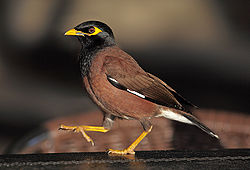Acridotheres
| Acridotheres | |
|---|---|
 |
|
| Common myna, Acridotheres tristis | |
| Scientific classification | |
| Kingdom: | Animalia |
| Phylum: | Chordata |
| Class: | Aves |
| Order: | Passeriformes |
| Family: | Sturnidae |
| Genus: |
Acridotheres Vieillot, 1816 |
| Species | |
|
Some 12-16, see text |
|
Some 12-16, see text
Acridotheres is a genus of starlings, the "typical" mynas, which are tropical members of the family Sturnidae. This genus has representatives in tropical southern Asia from Iran east to southern China and Indonesia. Two species have been introduced widely elsewhere. The common myna has been introduced to South Africa, Israel, Hawaii, North America, Australia and New Zealand, and the crested myna to the Vancouver region of British Columbia.
The Acridotheres mynas are generally dark or dull birds with and fluted calls like most starlings; the sexes are similar. They walk rather than hop, and have modifications to the skull and its muscles for open bill probing. They resemble the hill mynas (Gracula) with which they often co-occur, in having large white or buff wing patches which are obvious in flight and in some also naked areas on the head, but differ in that only the head plumage is glossy, and the underparts tend to be paler. The naked head patches are different in arrangement. Acridotheres mynas are also much more terrestrial than Gracula.
They have bowing courtship displays, whereas Gracula has no visual display. They lay unmarked pale blue eggs.
Several species have frontal crests which become covered with pollen when the birds take nectar from flowers, and may play a role in pollination.
Like most starlings, the Acridotheres mynas are fairly omnivorous, eating fruit, nectar and insects.
Despite being both called "mynas", the Acridotheres mynas are closer related to a group of mainly terrestrial starlings from Eurasia, such as the common starling, and also African ones like the Lamprotornis glossy-starlings. Among these, they are among the larger and duller species; they seem to be one of the major groups to evolve most recently. Apparently, they all arose from ancestors which arrived from Central Asia and adapted to more humid conditions in the Tropics. They presumably were isolated in about their current range when the evolutionary radiation to which they belonged - including the wattled starling and the Sturnia species - was fragmented by desertification at the start of the Early Pliocene, as Earth turned towards the last ice age 5 million years ago.
...
Wikipedia
